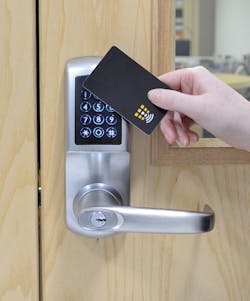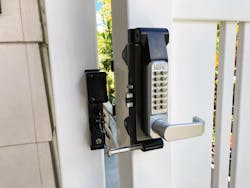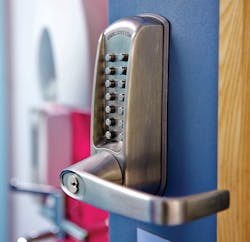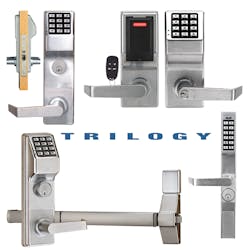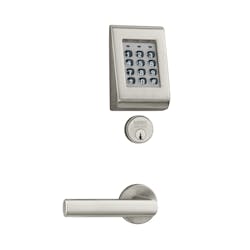Stand-Alone EAC: Pressing the Right Buttons
It’s difficult to fathom, but keyless push-button locks once were as exotic and cutting edge as are biometric locks today. Now, of course, locks that allow for the entry of a code, mechanical and electronic, to unlock the lock and open a door are commonplace.
They also are a bit old hat.
As more of everyone’s daily activities get moved to their smartphone, it’s become natural for that device to become a part of a person’s security routine. Demand for smart locks that allow for the use of mobile credentials — the key that won’t be forgotten or lost — has increased substantially and will continue to do so for the immediate future.
Given that, the question then becomes how does the now-humble push-button-lock fit in in an increasingly mobile-based security world?
“Very well, actually,” says Peter Lowenstein, vice president of sales at Alarm Lock. He predicts that push-button locks always will be a part of an overall security solution. “It’s the same idea as the old-school brass keys: ‘Brass keys, you’re crazy. Everything is going to go to credentials.’ No. No. There will always be brass keys. There will always be push-button locks.”
Brian Fie, senior product manager at dormakaba Americas, agrees.
“Push-button sales may decline but will not go away because of mobile,” he says. “They will coexist. There are too many factors that make push-button locks too appealing.”
Know the Code
The first mechanical push-button lock was aimed at providing access control to exterior doors at remote locations in extreme temperatures where neither keys nor electronics were appropriate or even possible. The locks had to be reliable and provide top security. They succeeded on both counts.
With the concept proven, manufacturers later brought electronics to bear, which added flexibility to the push-button lock.
Today, reliability and flexibility make up a large part of the appeal for push-button locks.
Aside from their lower price, mechanical push-button locks are known for their reliability and durability.
“There are no power failures with mechanical push-button,” says Scott Wojcik, national sales manager for LockeyUSA. “It’s just a solid, secure way to secure anything — door, fence, gate, you name it.”
Their mechanical operation also makes these locks attractive to a number of parties, including locksmiths who eschew electronics, Fie adds, because they don’t require software or firmware updates, don’t require changing batteries and are simple to use and administer.
“When you require someone to use their phone as a mobile key, that now becomes a $1,000 credential, in lieu of a free code,” he says. “This raises some questions, such as, what happens if the phone battery is low — will it still perform as a mobile key?”
As for electronics, the key word is flexibility. Electronics allows for remote access as well as data retrieval, as long as the lock is connected to the internet. It also allows for the use of that smartphone as part of a dual-credential scenario where someone has to punch in a code as well as present a mobile credential (or card).
“A lot of institutions and government agencies require two-credential identification,” says David Higginson, director of business development with SARGENT and Corbin Russwin. “They want you to be able to flash your phone but then also put a code in to gain entry.”
The Right Application
Push-button locks, particularly mechanical versions, are aimed at providing stand-alone access control at doors that either aren’t meant to be tied into a larger security system or are at locations where a large system isn’t necessary, such as a small office or even a residence.
“Why would I spend X number of thousands of dollars to try to connect [those doors] into what I call the big system that’s going to operate the rest of the building?” he says. “I can just put a stand-alone lock on there, mechanical or electronic, depending on whether I want time functionality. It’s a lot more cost-effective and doable.”
Outdoor applications, such as gates, are another natural location for a mechanical push-button lock.
“There’s no batteries, and there’s no PCB boards to get corroded up,” Welty adds. “You can put them out there, and even in harsh environments, they’ll still operate. They may not look the prettiest depending on the surroundings, but they hold up.”
The advantage for electronic push-button locks is that as they get “smarter,” they can connect with the internet and be managed through a computer or smartphone from anywhere. They also can connect with other locks. Increasingly, electronic push-button locks include modules and other components that allow for expandability beyond a stand-alone application, which is appropriate for small businesses that can expand.
Another application where electronic push-button locks are suited particularly gets back to their capability, depending on the model, to provide multicredential authorization — vacation rental properties.
Larry Schwalb, a security engineer with Houdini Lock & Safe of Philadelphia, says vacation-rental companies, such as Airbnb, have been a boon for push-button lock sales at his company. That’s because the rental companies prefer to send a code for timed access to a rental property for each member of a group, rather than, say, a mobile credential, which must be provisioned to an individual phone. As with other similar credentials, when the time is up, the code ceases to work.
“Things have changed dramatically,” he says, noting in particular the effects of the COVID pandemic. “We’re seeing use for digital code more, really, than I ever thought there would be a need for previously.”
Change It Up
While acknowledging the convenience of entering a code to unlock a lock, Schwalb has a couple of bones to pick with push-button locks. One is spying, or the ability of a person to detect a code by watching the placement of fingers on a keypad.
This has become a particular problem with the widespread use of technology. Schwalb notes a case where someone used a smartphone to detect the code punched into a client’s push-button safe lock — not by a person standing there, but by them leaving their phone behind “to charge” when it actually was surreptitiously capturing the code.
Another way criminals might be able to determine a code to a push-button lock is through wear. This generally is solved through the use of steel buttons that don’t wear down over time or by moving the numbers off the buttons to the lockbody.
A better solution to both issues, however, is to make sure codes are changed regularly.
“It’s just like your password on your email,” Welty says. “Every 30 days, you’re supposed to change it or whatever regularity your IT system requires — same thing with the code. It needs to be changed frequently.”
This leads to the other headache for Schwalb and other security pros — reprogramming the lock. Smart locks that have a keypad allow code reprogramming to be performed remotely. Short of that, however, the procedure can be problematic.
Some push-button locks, whether mechanical or electronic, require multiple complicated steps to reprogram. Others require taking the lock off the door first. Schwalb says it’s a difficult task for end users, particularly with respect to mechanical push-button locks.
“It’s always been a difficult process to set the combo and recover the combo on mechanical push-button locks,” he says. “Even as professionals, unless you’re doing it quite often, like if you work in some type of institution or commercial property that had a lot of them, you’re going to have to reflect on notes.”
Manufacturers acknowledge the problem and are working to simplify the process. One innovation is to make it so the lock can be reprogrammed without having to remove the lock from the door.
“It’s especially important if you’re using that on a door that has an exit device on the other side, because to get the lock off the door, you have to take the whole exit device off the inside of the door to get to the screws to take the lock off the outside of the door,” Welty says. “It’s a real, royal pain.”
Although he agrees there’s a problem, Wojcik wouldn’t want to change the lock too much and compromise the security in the process.
Lowenstein agrees. He says outside of a few tweaks to the look of his company’s push-button locks, he doesn’t foresee too much change.
“It’s a tried-and-true lock where some people still have those locking their doors 10 and 15 years later,” he says. “As far as the basic functionality, we’re not going to mess with that at all.”
Following are a few options, mechanical and electronic, where stand-alone access control is desired:
Alarm Lock Trilogy T2 series
In the case of the venerable Trilogy, you don’t have to decide right away.
The Trilogy T2 line of electronic push-button locks is Alarm Lock’s traditional stand-alone or “offline” lock. However, it long has been upgradable through a kit that turns the lock from stand-alone operation to one that’s connected to a network. That makes it particularly suited to what Lowenstein calls “the small-business scenario,” where the potential for future growth in the same location might require expansion from one door into a connected EAC system.
The Trilogy T2 comes in cylindrical, mortise, narrow-stile and exit trim variations, and up to 100 user codes are allowed in either model. The cylindrical DL2700 is ANSI/BHMA Grade 1 rated and provides for up to 200,000 cycles (about 5 years) on a set of five AA batteries. This model also has a lockdown version that allows for the lockdown of up to four locks at once through the use of a fob.
More info: www.alarmlock.com
Lockey SUMO GL2
The mechanical SUMO GL2 is a surface-mounted gate lock that fits in with Lockey’s strategy of focusing more on gate applications. Part of that strategy is to make installing a lock on a gate like doing it on a regular door by adding an easy-installation surface-mounting kit, Wojcik says.
Another part is in the lock’s adaptability to different types of gates, including chain link through an additional adapter. The SUMO GL2 can be mounted on gates that have a thickness of 1-1/4 inches up to 5 inches with an extension kit.
Finally, it’s also the lock’s functionality. The SUMO GL2 includes a keyed cylinder lockout function that renders the push buttons inoperable, even if the correct code is entered. This is particularly beneficial for gates that protect swimming pools at a residence or a multifamily housing complex.
“You can give a combination during the day and then make sure the combination is locked out at night” by locking the gate with a key, he says.
The SUMO GL2 locks automatically when the gate closes, and it’s equipped with a passage function. It comes in single-side or double-side (back to back) versions and has a lifetime mechanical warranty.
More info: lockeyusa.com
Codelocks CL600 series
What’s noticeable about the CL600 series of mechanical push-button locks is that it has a built-in shroud to prevent potential spying when you punch in a code. What isn’t noticeable is that the locks can be reprogrammed without having to take them off the door and shuffling wafers, as is typical with mechanical push-button locks.
Welty describes the procedure, which is known as QuickCode: You insert a key into the keyed cylinder and turn counter-clockwise (or clockwise depending on the handing) to put the lock in “programming mode,” punch in the new code and turn the key back.
“The [lock] has just been ‘rekeyed,’” he says. “I think that’s more important than [preventing] spying.”
The CL600 series comes in tubular latch, mortise and exit trim variations. (The mortise version is ANSI/BHMA Grade 1.) The tubular latch version also can be double-sided (back to back) to require a code when exiting as well as entering a doorway.
The CL600 series has a limited lifetime warranty and is suitable for wood doors 1-3/8 – 2-3/8 inches thick, but gatebox kits allow the tubular latch version to be mounted onto a gate.
More info: www.codelocks.us
SARGENT KP Series
“It solves what [the customer is] looking to do without getting deeper into the dollars,” he says.
Because it’s electronic, the KP Series also allows for more code options than mechanical push-button locks, up to 100, as well as one-time user codes that provide one-time entry for visitors or maintenance people.
It also allows for emergency entry codes when battery power is low. (Four C batteries provide 40,000 cycles.) Key override is standard on the cylindrical version and optional on the mortise and exit trim versions.
Three incorrect codes in a row will disable the keypad temporarily, and the last 15 codes to be entered can be accessed and printed.
Although the KP Series is meant for interior doors, weather-resistant gasketing will allow for the locks to be used for exterior applications.
More info: www.sargentlock.com
dormakaba Simplex series
Simply, the Simplex series started the push-button stand-alone access control market decades ago. It remains essentially the same as the original product, although the Simplex series has expanded significantly.
The series now includes cylindrical knob (1000), cylindrical latch (L1000), mortise latch (8100), deadbolt thumbturn (900), auxiliary latch (7100), Grade 1 cylindrical, mortise and exit trim (5000) and even cabinet lock (9600) versions.
All have the same five-button keypad, in different arrangements depending on the lock, and basic functionality, and all can be reprogrammed without having to take the lock off the door.
Some of the locks include “side walls” to prevent spying, but Fie notes that the locks’ capability to enter two numbers simultaneously can make the code “stronger” and more difficult to read.
The 1000, L1000/8100 and 5000 models allow for passage mode and lockout, which disables the lock from the inside, so the code won’t work, just the key override.
More info: www.dormakaba.com
About the Author
Will Christensen
Senior Editor
Will Christensen is senior editor at Locksmith Ledger International. He has been an editor and reporter at magazines and newspapers for more than 30 years.
